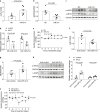Endothelial MicroRNA-214 Confers Angiotensin II Hypertension by Targeting eNOS in Mice
- PMID: 40451155
- PMCID: PMC12233992
- DOI: 10.1159/000546674
Endothelial MicroRNA-214 Confers Angiotensin II Hypertension by Targeting eNOS in Mice
Abstract
Introduction: MicroRNAs have been increasingly recognized for their roles in cardiovascular diseases. Among these microRNAs, miR-214 was reported to be involved in hypertension. However, the role of endothelial miR-214 in hypertension is still unknown. The aim of this study was to determine the role of cell-specific miR-214 on regulating blood pressure, as well as the potential mechanisms.
Methods: We detected the levels of miR-214 in hypertensive mice and cultured mouse aortic endothelial cells (MAECs). In addition, mouse miR-214 inhibitor, miR-214 mimics, vascular endothelial cell-specific miR-214-deficient mice, smooth muscle cell-specific miR-214-deficient mice, renal proximal tubule cell-deficient mice, and various cellular and molecular techniques were employed to define the role of miR-214 in Ang II-induced hypertension.
Results: In mice and MAECs, Ang II significantly enhanced miR-214 levels, and anti-miR-214 markedly attenuated Ang II hypertension in line with enhanced eNOS/p-eNOS in aorta. Then, we generated vascular endothelial cell-specific miR-214 knockout mice and found an antihypertensive phenotype in endothelial miR-214 conditional knockout mice after Ang II treatment. In normotensive animals and MAECs, exogenous miR-214 administration reduced eNOS expression at protein and mRNA levels; in contrast, anti-miR-214 played an opposite role in regulating eNOS. By luciferase assay, our results confirmed that eNOS was a direct target gene for miR-214 in endothelial cells. However, smooth muscle cell-specific or renal tubular cell-specific deletion of miR-214 did not alter Ang II-induced hypertension.
Conclusion: Our findings suggested that endothelial miR-214 promoted Ang II hypertension by targeting eNOS in mice, which increased the understanding on the pathogenic mechanism of hypertension.
Keywords: Ang II; Endothelial NO synthase; Endothelial cells; Hypertension; miR-214.
© 2025 The Author(s). Published by S. Karger AG, Basel.
Conflict of interest statement
The authors declare that they have no known competing financial interests or personal relationships that could have appeared to influence the work reported in this paper.
Figures







References
-
- Wong ND, Franklin SS. Epidemiology of hypertension. J Am Soc Hypertens. 2014;8(10):760–4; quiz 764. - PubMed
-
- Cechova S, Zeng Q, Billaud M, Mutchler S, Rudy CK, Straub AC, et al. Loss of collectrin, an angiotensin-converting enzyme 2 homolog, uncouples endothelial nitric oxide synthase and causes hypertension and vascular dysfunction. Circulation. 2013;128(16):1770–80. - PubMed
-
- Coelho SC, Berillo O, Caillon A, Ouerd S, Fraulob-Aquino JC, Barhoumi T, et al. Three-month endothelial human endothelin-1 overexpression causes blood pressure elevation and vascular and kidney injury. Hypertension. 2018;71(1):208–16. - PubMed
MeSH terms
Substances
LinkOut - more resources
Full Text Sources
Medical
Miscellaneous

